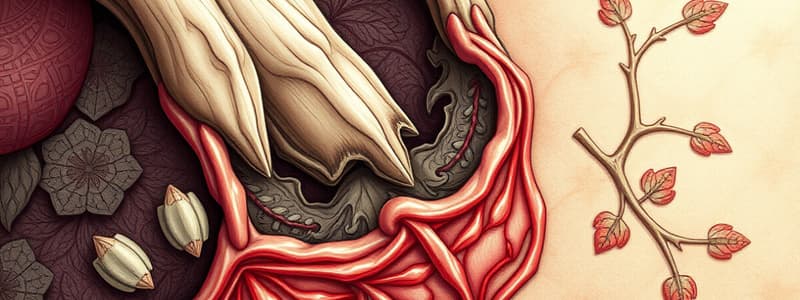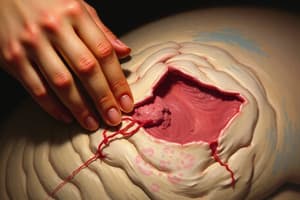Podcast
Questions and Answers
What role do platelets play in the hemostatic phase of wound healing?
What role do platelets play in the hemostatic phase of wound healing?
- They release molecules that prevent bleeding. (correct)
- They promote the formation of a mature scar.
- They regulate inflammation signals by themselves.
- They are responsible for collagen synthesis.
How do ELF-EMFs influence the inflammatory phase of wound healing?
How do ELF-EMFs influence the inflammatory phase of wound healing?
- They modulate cytokine production to reduce inflammation. (correct)
- They increase pro-inflammatory cytokine levels.
- They completely suppress all immune responses.
- They have no significant effect on inflammation.
In which phase of wound healing do fibroblasts differentiate into myofibroblasts?
In which phase of wound healing do fibroblasts differentiate into myofibroblasts?
- Remodeling phase (correct)
- New tissue formation phase
- Proliferative phase
- Hemostatic phase
What is a significant effect of ELF-EMFs during the proliferative phase of wound healing?
What is a significant effect of ELF-EMFs during the proliferative phase of wound healing?
Which of the following chronic conditions can lead to non-healing wounds?
Which of the following chronic conditions can lead to non-healing wounds?
What is the primary role of ELF-EMFs in the context of cellular senescence?
What is the primary role of ELF-EMFs in the context of cellular senescence?
How do ELF-EMFs aid in pain management during wound dressing changes?
How do ELF-EMFs aid in pain management during wound dressing changes?
What is a potential benefit of tailoring different types of ELF-EMF exposure to stages of wound healing?
What is a potential benefit of tailoring different types of ELF-EMF exposure to stages of wound healing?
What are the underlying mechanisms still needed to be fully understood regarding ELF-EMF application?
What are the underlying mechanisms still needed to be fully understood regarding ELF-EMF application?
What barrier to wound healing is associated with cellular senescence?
What barrier to wound healing is associated with cellular senescence?
Flashcards are hidden until you start studying
Study Notes
Wound Healing Process
- Wound healing involves four well-regulated phases: hemostasis, inflammation response, new tissue formation, and tissue remodeling.
Hemostatic Phase
- Platelet activation occurs, releasing growth factors and cytokines to prevent bleeding.
Inflammatory Phase
- Immune cells such as neutrophils, monocytes, and lymphocytes are recruited to prevent infection and remove dead tissue.
- An imbalance in pro-inflammatory and anti-inflammatory signals can lead to chronic wounds.
New Tissue Formation
- Cellular proliferation and migration of fibroblasts, keratinocytes, and endothelial cells initiate within 2 to 10 days post-injury.
Remodeling Phase
- Fibroblasts differentiate into myofibroblasts, producing extracellular matrix (ECM) leading to mature scar formation.
- This phase may last for a year or longer.
ELF-EMFs and Inflammatory Phase
- Extremely Low-Frequency Electromagnetic Fields (ELF-EMFs) can modulate the inflammatory phase by reducing inflammation.
- ELF-EMFs influence cytokine production and inflammatory signaling pathways, aiding the transition to an anti-inflammatory state.
ELF-EMFs and Proliferative Phase
- ELF-EMFs enhance cell migration and angiogenesis while upregulating growth factors necessary for tissue regeneration.
- They regulate matrix metalloproteinases (MMPs), crucial for ECM remodeling.
ELF-EMFs and Remodeling Phase
- ELF-EMFs influence collagen synthesis and ECM remodeling, vital for tissue maturation.
- Their effects on collagen depend on frequency and exposure duration, promoting healing of skin ulcers.
Non-Healing Conditions
- Chronic conditions such as diabetes and hypertension may prevent wound healing due to poor blood supply, infection, and cellular aging (senescence).
- ELF-EMFs may regulate inflammation, reduce biofilm formation, and enhance immune response in these cases, though their effects on bacterial growth are contentious.
Effects on Senescent Cells
- Cellular senescence contributes to chronic inflammation, hindering wound healing.
- ELF-EMFs can reverse senescence in fibroblasts and keratinocytes, promoting cell proliferation and migration, thus enhancing ECM synthesis and reducing fibrosis.
Pain Management
- Pain during wound dressing changes can impede healing; ELF-EMFs can alleviate pain and inflammation by modulating pain receptors and inflammatory pathways.
- ELF-EMFs serve as a complementary treatment, potentially reducing pain without opioid side effects.
Conclusion
- ELF-EMFs show promise in aiding wound healing across various phases.
- While in vitro and ex vivo research support their therapeutic role, more in vivo studies are required for confirmation.
- Tailored ELF-EMF exposure could be developed for different wound healing stages, optimizing clinical applications.
Studying That Suits You
Use AI to generate personalized quizzes and flashcards to suit your learning preferences.



